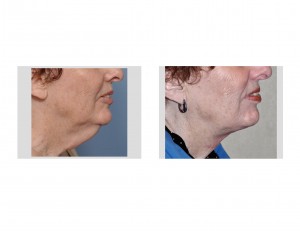Background: Aging of the face takes on many manifestations but inevitably the neck gets involved. Loss of the neck angle occurs as skin begins to sag, falling over the jawline in jowls and draping downward from the central portion of the neck. In more advanced aging, the platysmal muscles of the neck separate and fat prolapses out from underneath it adding to whatever fat collection already exists in the subcutaneous space. With enough time, the dreaded neck wattle appears.
The traditional and most ideal treatment for neck wattles is a facelift. The combination of a neck-jowl lift (aka facelift) changes the neck and does so by placing fine line scars around the ears and right under the chin in a skin crease. Despite the numerous benefits of a facelift, it is associated with greater cost and recovery. As a result some patients, particularly older men, seek a simpler solution and opt for a direct necklift procedure.
Most direct necklifts are done in men as they have less fear of neck scars and value a quick recovery of greater importance. They also have the benefit of excellent scar healing in the beard skin of the male neck. Women rarely do direct necklifts as they are more concerned about visible neck scars and are willing to have a more extensive operation to avoid them. There are also concerns about how well such scars heal in the hairless skin of the female neck.



The direct necklift can be done in women just as successfully as in men. For the really low hanging neck wattle, it can be a very cost-effective alternative that does not produce scars that look worse than that of men. It does create a vertical scar which can create a banding effect that may necessitate a z-plasty scar revision if it occurs. But for the economically challenged, that potential scar outcome can be a worthwhile trade-off for the complete elimination of the neck wattle and the return of a tight neck that they may not have had for decades.
Case Highlights:
1) Neck wattles are a common feature of facial aging in either men or women. They often occur in older patients as it is a sign of advanced aging.
2) The traditional treatment for neck wattles is a facelift which incorporates a neck reshaping procedure as part of it.
3) While direct necklifts are usually opted for by men with scars that usually do well in beard skin, it can be an acceptable procedure in older women if they can accept the neck scars.
Dr. Barry Eppley
Indianapolis, Indiana


